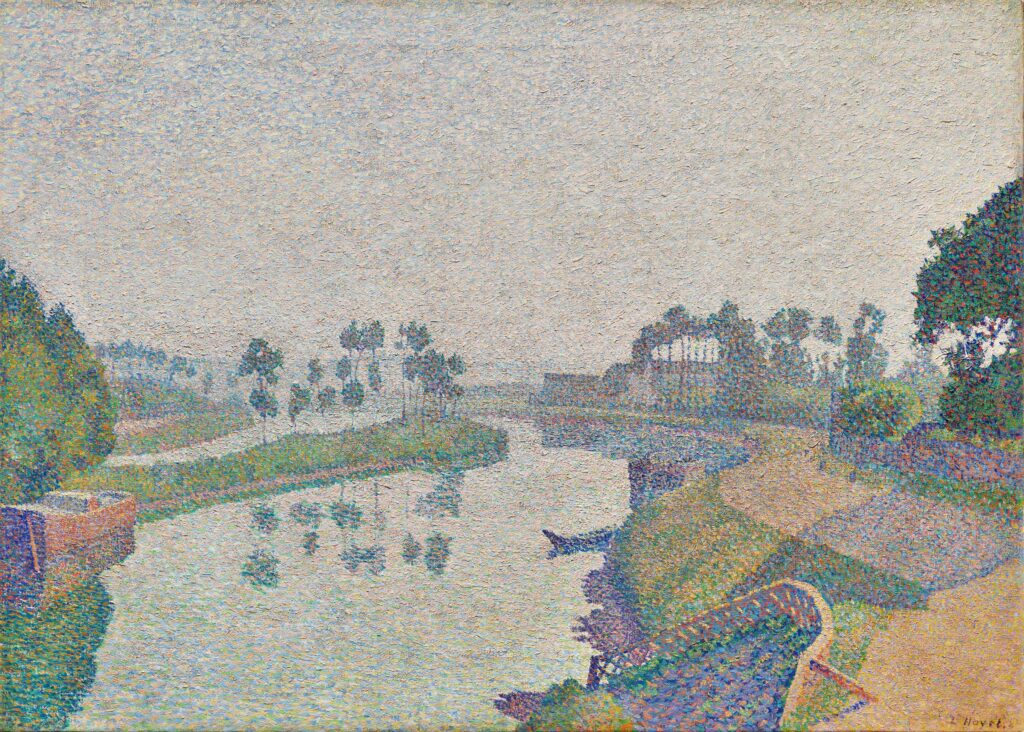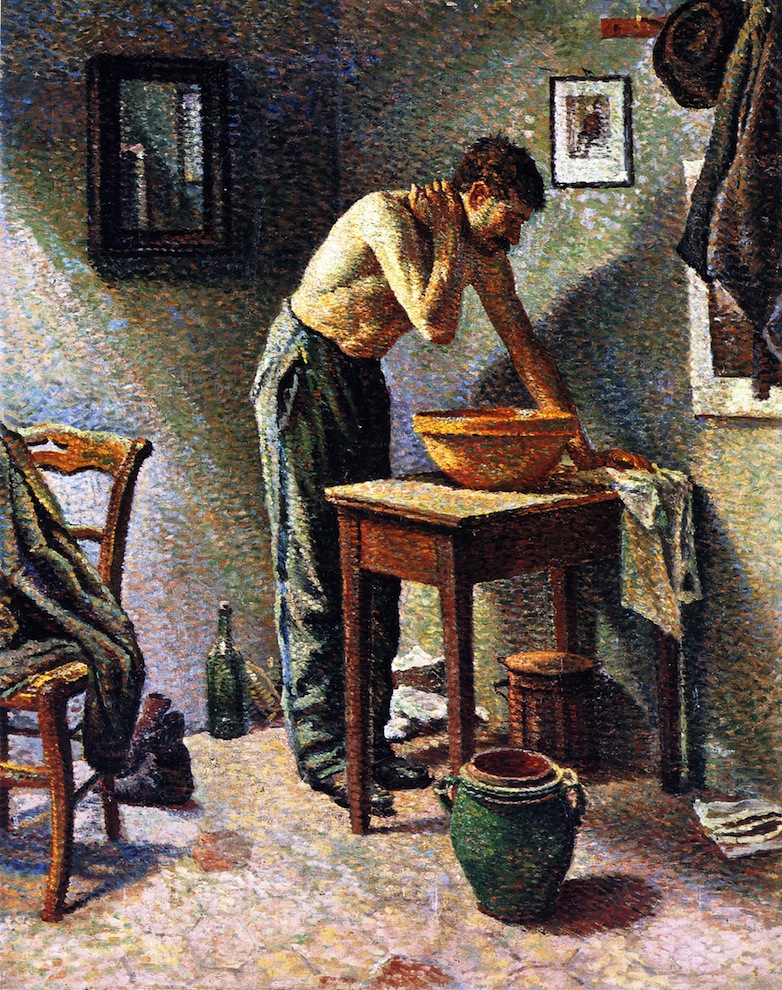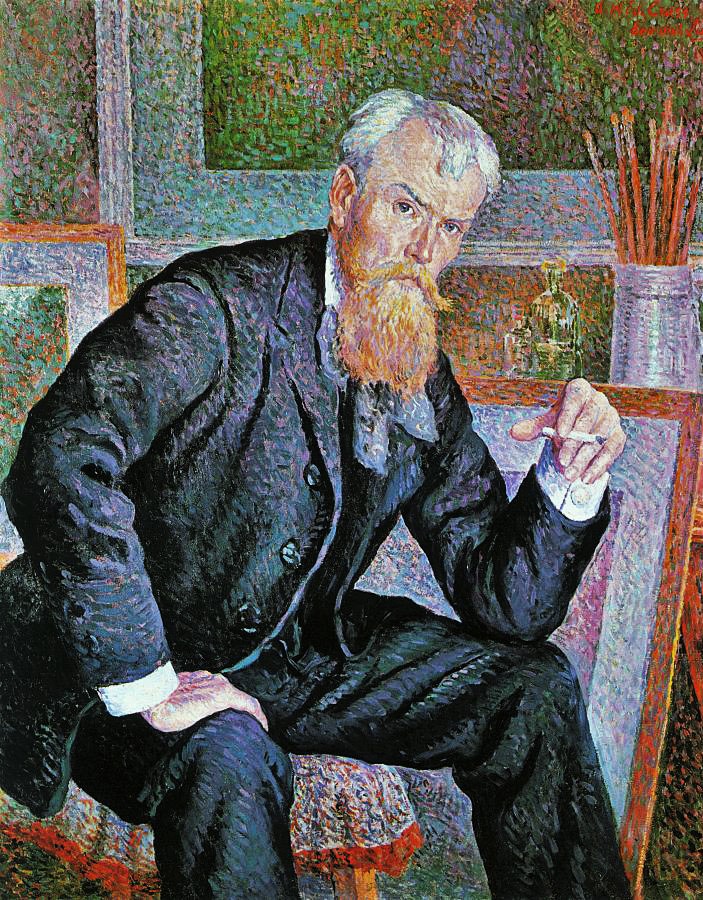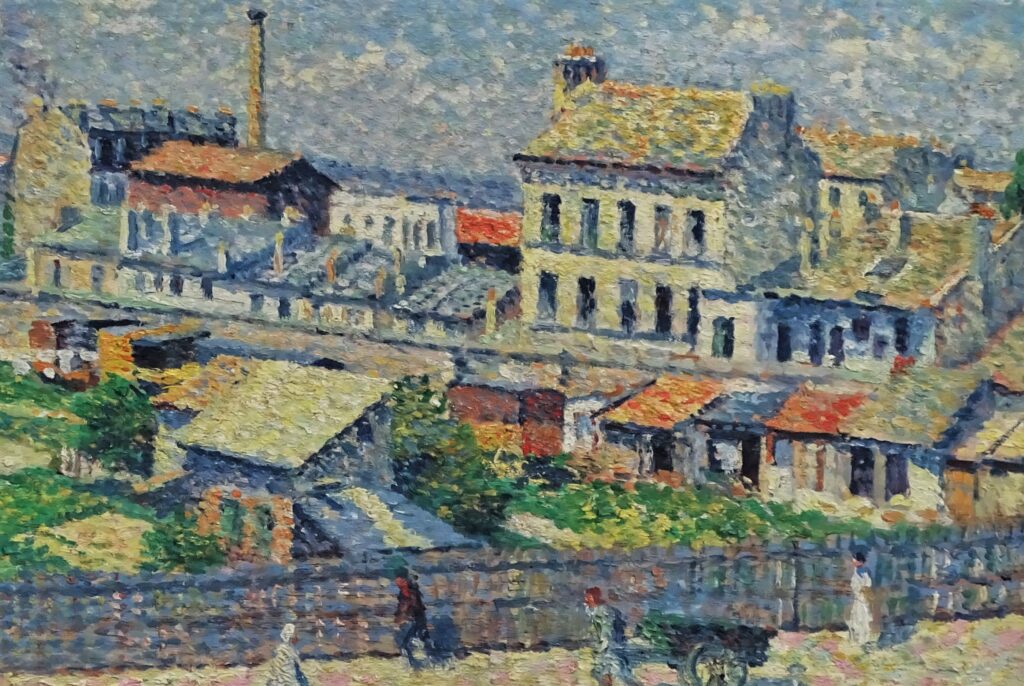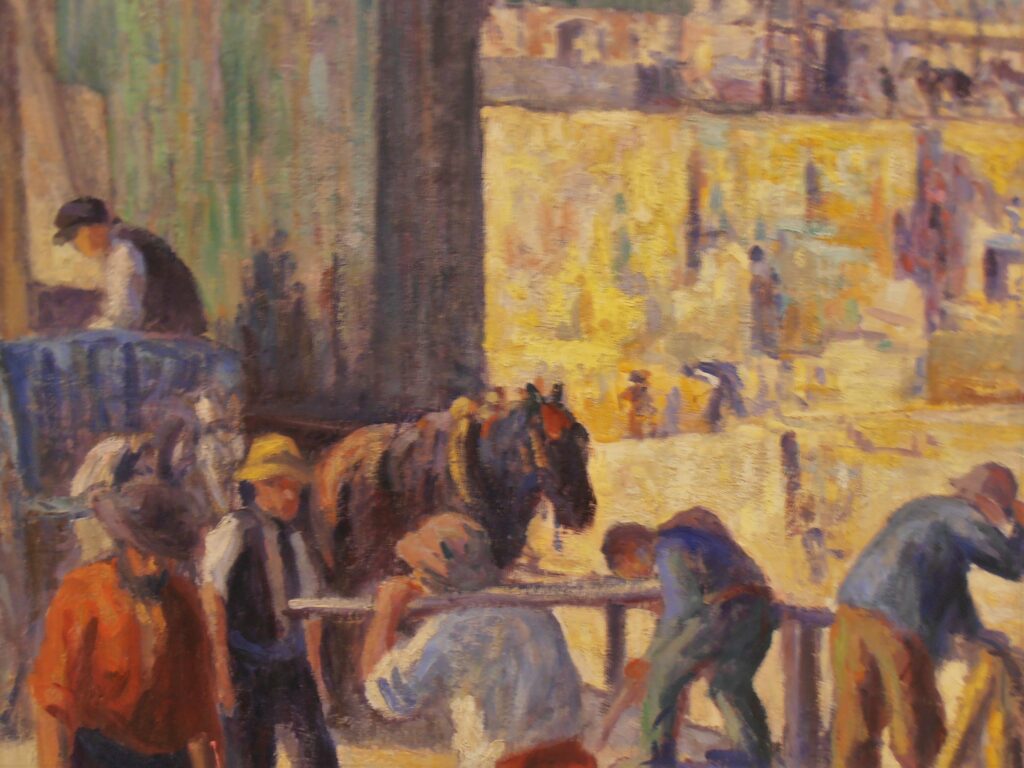Please do not quote from this webpage, which is under construction.
The information is incomplete and maybe partly incorrect.
Neo-Impressionism
Neo-Impressionists
Introduction:
The most important representatives of Néo-Impressionism are Seurat and Signac. Other representatives are Camille Pissarro (from 1886-90) and Schuffenecker. On this page you will find an overview of other (important) Neo-Impressionists. For many of them Néo-Impressionism was just a fase and before and after painted in a symbolist style, fauvistic, cubistic and/or abstract. Many didn’t strictly apply the principels of Pointilism and Divisionism, at least not all the time.
Angrand, Charles (1854-1926):
Angrand was a teacher and in that sense an amateur painter. He attended the art-academy in Rouen. From 1882-96 he lived in Paris. In 1884 he was co-founder of the Société des Artistes Indépendants and exhibited there from 1884-88, 1890-94 and again in 1901+1903 and from 1905 till at least 1914. Painted with Seurat at Île de la Grande Jatte. He first painted in a Naturalist style, that can be compared with Bastien-Lepage, Millet and Pissarro. 1884 onwards in a Neo-Impressionist style and 1887 onwards in a Pointillist / Divisionist style. Between 1891 and 1901 he gave up painting and only made drawings. Between 1896 and 1926 he lived withdrawn in Normandy, but kept corresponding with Cross↓, Luce↓ and Signac.
Sources: R56,p56-61;R300,p131;R16,p62;R229,p107-109+125. More info and pictures: WikiPedia (iR3); WikiMedia (iR6).
Cambier, Louis-Gustave (1874-1949):
At first he followed a more traditional path and exhibited at the Salon de la Société des Artistes Français. In 1914 he moved to the Mediterrenean Sea and became acquainted with Renoir and Signac. Influenced by them he made (néo-)impressionist landscapes and village views. After 1924 he mainly painted portraits. (R56,p177)
Cousturier, Lucie (1876-1925):
Was teached around 1900 by Signac, started to paint in a divisionist style. friendships with Cross↓ and Luce↓. Owned La Grande Jatte of Seurat. Painted still-lifes, nudes and (Mediterrenean) seaviews. She exhibited at the Salon des Indépendants, La Libre Esthétique. Published monographs about Seurat, Signac, Roussel and articles about Bonnard, Cross, Denis.
Cross, Henri-Edmond (1856-1910):
Born 1856/05/20 as Henri-Edmond-Joseph Delacroix in Douai. Pupil of Carolus-Duran, François Bonvin (1875), Alphonse Colas (1878-81) and Émile Dupont-Zipcy (1881). Exhibited at the Salon de la Société des Artistes Français (1881). He was co-founder of the Société des Artistes Indépendants and exhibited almost yearly at their salons. Also exhibited with Les XX (at least in 1889), La Libre Estétique (several times). There was in 1905 a solo exhibition at Druet (with 30 oils + 30 watercolours), in 1907 at Bernheim-Jeune and in 1911 a large retrospective in Douai. One of his works was exhibited in the “impressionist” room at an exhibition in Rome in 1913. Cross had friendships with Seurat, Signac, Angrand↑, Dubois-Pillet↓, Luce↓, Théo van Rysselberghe↓. Since 1883 he wintered in the south of France, moving permenantly in 1891 to Cabasson and later to Saint-Clair. He had close contacts with Signac, who had moved to closeby Saint-Tropez in 1892. Developed with Signac Divisionism from the dots of Pointilism to mosaic-like blocks of paint. Untill about 1890 Cross had painted more in a Realist and an impressionist style. He stated that he was “far more interested in creating hormonies of pure colour, than in harmonizing the colours of a particular landscape” (iR3). Cross also did meet future Fauve artists like Derain, Marquet and Matisse and influenced them. Cross had anarchist sympathies. Cross died 1910/05/16 in Saint-Clair (Var).
Sources: R56,p158-160;iR216;R300,p140-3;R16,p107;R229,p461-3. More info and pictures: HenriEdmondCross.org; WikiPedia (iR3); WikiMedia (iR6); WikiArt (iR7); Meisterdrücke (iR155).
Dubois-Pillet, Albert (1845-1890):
Born as Louis-Auguste-Albert Dubois in Paris in 1845 (or 1846), he died in 1890 in Le Puy-en-Velay (Haute-Loire). He was a sunday painter having a career in the army. He exhibited at the Salon of 1877 +79 some still lifes, but was refused from 1880-84 at it’s successor the Société des Artistes Français. He was co-founder of the Société des Artistes Indépendants and exhibited at their salons from 1884-91. At first he was an active member, but later he was ordained to withdraw. According to some sources he had even been president (R9), but this is not affirmed by other sources (R3,p694;R39,p41). Degas prevented his partaking in the last ‘impressionist’ exposition in 1886 (R56), another source mentions that Guillaumin decided not to invite him for this exposition (R2,p425). Attended La Nouvelle Athènes. Was praised by the art-critic Félix Fénéon. Exhibited with Les XX in Brussels in 1888 +90. First painted in a Naturalist style, later in a Pointillist style. Developed his own colour-theory introducing the term ‘passages’ referring to the relations between colours and aiming to inforce ‘colour rhyme’. Posthumous there was in 1891 at the Salon des Indépendants a retrospective held with 67 pictures.
Sources: R9,p254;R56,p62;R300,p147;R16,p129;R229,p572-4;R207,p42. More info and pictures: WikiPedia (iR3); WikiMedia (iR6).
Fer, Edouard (1887-1959):
Pupil at the École des Beaux-Arts since 1905. Received a medal at the Salon de la Société des Artistes Français in 1912. Related to Signac. Started to paint in a divionist style around 1912. Published two articles on the scientific principles of Néo-Impressionism. (R56,p173)
Léo Gausson (1860-1944):
Léo(n) Gausson was born in Lagny-sur-Marne. Friend of Luce and Cavallo-Peduzzi. First painted in a Barbizon style. Painted from 1887-90 in a Neo-Impressionist style. From 1890-1896 he is influenced by Les Nabis and other symbolists. After 1896 he almost completely stopped with painting and exhibiting. Exhibited at the Salon des Indépendants (1887-95), with Les XX , the Salon des Cent, the Salon de la Rose+Croix and with the peintres Impressionnistes et Symbolistes .
Sources: R56,p74-77;R229,p721/2. More info and pictures: WikiPedia (iR3); WikiMedia (iR6), Artnet (iR13). The Musée Gatien-Bonnet in Lagny-sur-Marne has several works of Gausson. In 2019 there was an exhibition of Gausson and Luce in Mantes-les-Jolies (iR23).
Louis Hayet (1864-1940):
Born in Pontoise, moved to Paris in 1885. Worked as a decorative painter. Autodidact, studied the colour theories of Chevreul. Already in 1883 made watercolours composed of short brushstrokes with unmixed, primary colours. Painted since 1886 in a divisionist style. Made many experimental works on small size. Had contacts with Camille and Lucien Pissarro, Seurat and Signac. He didn’t accept the invitation of Camille Pissarro to join the 8th ‘impressionist’ exposition in 1886 (R56). Another source mentions that Guillaumin decided not to invite him for this exposition (R2,p425). Withdraw in 1890, quit his membership of the Société des Artistes Indépendants and stopped working in a divisionist style. After 1918 he made many still lifes. Exhibited at the Salon des Indépendants (1889), the Salon de la Société des Artistes Français, with Les XX (1890) and with the peintres Impressionnistes et Symbolistes (1894-97). Small solo exhibitions in Paris between 1902 and 1904, but unsuccesful.
Sources: R56,p70+71; R300,p38-43+171; R229,p833. More info and pictures: WikiPedia (iR3); WikiMedia (iR6), Artnet (iR13), Invaluable (iR17), Leighton (iR317). Guy Dulon: Louis Hayet (1864-1940); peintre et théoricien du néo-impressionnisme. Paris?, 1991.
Auguste Herbin (1882-1960):
Painted from 1901-09 in a néo-impressionist style and later more fauvistic. Since 1909 he was influenced by Cubism and later painted in a ‘non-objective’ style. He exhibited at the Salon des Indépendents (1906-09). (R56,p168;R229,p845)
Georges Lacombe (1868-1916):
Lacombe started around 1904 to paint in a Néo-Impressionist style, but is mainly known as a post-Impressionist.
Fernand Lantoine (1861-1944):
Another source states he was born 1876 in Maretz (Nord) and maybe died in 1946 (R285,p1003). Lived in Paris and Brussels. Exhibited at the Salon des Indépendents (1908-14) and La Libre Esthétique (1914). Painted landscapes and marines. (R56,p176;R229,p1003/4)
Achille Laugé (1861-1944):
Since 1881 student at the École des Beaux-Arts and pupil of Cabanel and Jean-Paul Laurent. Painted from 1888-96 in a more Pointillist style systhematicly using thin brushstrokes. After 1905 he used more loose broader and thicker brushstrokes. Exhibited at the Salon des Indépendents (1893+94+1906) and with Les Nabis namely in 1894. (R56,p182;R300,p178;R229,p1016)
Ernest-Joseph Laurent (1859-1929):
Shared an appartment with Seurat and Aman-Jean, all attended the studio of Henri Lehmann around 1878. Received a travel grant in 1885 and travelled with Aman-Jean and Henri Martin↓ in Italy. Won the Grand Prix de Rome in 1889 and stayed for 4 years at the Villa Medici in Rome. Received a 2nd class medal at the Exposition Universelle in 1889 and a 1st class in 1900. Received a 2nd class medal at the Salon (SdAF) in 1895, where he exhibited since the end of the 1870s. Since 1919 member of the Académie des Beaux-Arts, professor at the École des Beaux-Arts and had his own studio. In 1911 solo exhibition at Durand-Ruel and in 1930 a posthumous retrospective at the Musée de l’Orangerie.
Sources: R297,p17/18+276;R56,p174.
Henri Lebasque (1865-1937):
Attended the École des Beaux-Arts. Pupil of Bonnat. Made his debut at the Salon de la Société des Artistes Français in 1896. Shortly after he exhibited at the Salon des Indépendants (1893-96 + 1901-12 +1914) and at the Salon d’Automne. Moved to the Mediterrenean, first to Saint-Tropez, later to Le Cannet. His works shows similarities with Impressionism, Bonnard and Matisse.
In the future I will make a seperate page on Henri Lebasque.
Sources: Bazetoux (2008=CR=R307);R308;R309;R16,p170-3;R229,p1027-9.
Léveillé, André (1880-1962):
Born 1880 in Lille and maybe died in 1963. Autodidact. André Léveillé made his debut at the Salon des Indépendants in 1911 and later was, beside Luce, vice-president. Monneret mentions he exhibited from 1912-14 (and maybe also later on). Also exhibited at the Salon d’Automne. Made landscapes in the Auvergne. First painted in a Néo-Impressionist style, later in a Cubist style and later more Naturalistic. He was director of the museum Palais de la Découverte in paris from 1937-1960. (R56,p162;R229)
Luce, Maximilien (1858-1941):
He came from a simple environment. Followed between 1872-85 different art-lessons, including the Académie Suisse. Meanwhile he worked at a printing company. Started to paint in a Divisionist style 1885 onwards, around 1887 he was seen as one of the mainfigures. His brushstrokes varied in form, direction and impasto and created energetic rhythms. Luce had anarchist sympathies and was imprissoned in 1894; around 1900 he withdraw from the political life. He made illustrations for the periodicals La Révolte, Le Père Peinard and Les Temps Nouveaux. Around 1895 onwards his style became more loose and more impressionistic; he abandoned the systhematic separation of tones and followed more his instinct. He painted often at the Mediterrenean. He made many paintings from the Notre Dame from his window at different times of day. Close friend of Angrand↑. He had a contract with the Bernheim-Jeune Gallery.
Luce exhibited at the Salon des Indépendant since 1887, where he was vice-president since 1901 and president from 1935-1941. He also exhibited at other exhibitions in Paris in 1892/93, 1894 (with Signac), 1895/96 (at Bing), 1899 (at Durand-Ruel), 1919/20 (Indépendants), 1933/34 (at Wildenstein), 1937 (international exhibition), 1938 (XIX siècle). Luce also exhibited in Brussels with Les XX (1888+92) and La Libre Esthetique (1895+97+1900+04). Luce participated in international exhibitions at the Berliner Sezession (1900), at Paul Cassirer in Hamburg (1903), in Düsseldorf (1928), in Rotterdam (1936/37), in New York (1937). Two of his works were exhibited in the “impressionist” room at an exhibition in Rome in 1913. There were several solo exhibitions held, at Durand-Ruel (1899+1921), at Druet (1904), at Bernheim(-Jeune) (1907+09+12+16+29) and a retrospective in 1941 at the Berri-Raspail gallery.
Sources: Ferretti Bocquillon (2010=R306);R56,p64-69;R3,p694;R39,p41;R300,p189;R16,p181-5;iR261;R229,p1107-10. More info and pictures: WikiPedia (iR3); WikiMedia (iR6).
Martin, Henri (1860-1943):
Born as Henri-Jean-Guillaume Martin. Received a travel grant in 1885 and traveled with Aman-Jean and Laurent↑ in Italy. Painted since 1889/90 in a more neo-impressionist style and used it to paint poetic symbolist works, including large historical and literary works and later also in landscapes. Signac in 1897 criticised his use of the divisionist technique. Received many commissions for decorative wall paintings. He made his debut at the Salon (SdAF) in 1880 and received a 1st class medal in 1883 and a medal of honour in 1907. He received a 1st class medal at the Exposition Universelle in 1889 and a Grand Prix in 1900. Exhibited at the Salon de la Rose+Croix (1892) and at the Expositions Société Nouvelle (1900-22). Became member of the Académie des Beaux-Arts in 1917.
Sources: R298,p121; R297,p280; R56,p179+180; R300,p194-7. See links for info + pictures on the internet:
Ménard, Émile René (1861-1930):
Admirer of the Barbizon painters. Attended the Academie Julian (1880). Exhibited at the Salon (SdAF) (1883 onwards), at the SNBA (member since 1891), the Société Internationale at Georges Petit (1892), the Libre Esthétique (1897) and at the Société Nouvelle (1900-22). Received a 3rd class medal at the Exposition Universelle in 1889 and a 1st class medal in 1900. Was in 1923 co-founder of the Salon des Tuileries. Since 1926 Member of the Académie des Beaux-Arts.
Sources: R298,p131; R297,p316; see links for info + pictures on the internet:
Metzinger, Jean (1883-1956):
Mainly known as Cubist, but painted from about 1905-08 in a divisionist style, together with his friend Robert Delaunay. Exhibited at the Salon des Indépendants (1903-1914+), the Salon d’Automne. (R56,p170/1)
Petitjean, Hippolyte (1854-1929):
Pupil of Cabanel, alter influenced by Puvis de Chavannes. Admired Millet and Ingres. Met Seurat in 1884. Started to work in a divisionist style since 1887 or 1890 and did so till around 1894. Later depicted mythological and bathing scenes. Regularly exhibited at the Salon de la Société des Artistes Français from 1880-90. Exhibited at the Salon des Indépendants (1891-96 +1901-14+), the Exposition Impressionnistes et Symbolistes (1892), Les XX (1893). 1897 onwards he exhibited again at the Salon de la Société des Artistes Français. In his last years he made Néo-Impressionist watercolours, hardly exhibited and died poor. (R56,p163;R300,p227;R229,p1358/9)
Théo van Rysselberghe (1862-1926):
In the future I will make a separate page on Théo van Rysselberghe.
He exhibited irregularly at the Salon des Indépendants (1890-1906). Two of his works were exhibited in the “impressionist” room at an exhibition in Rome in 1913.
Sources: Holberton (2006=R68);R300,p244-7;R229,p1522/3- iR216.
Ségal, Arthur (1875-1944):
Studied in Berlin, Munich, Paris and Italy. Influenced by Segantini, Van Gogh, Matisse and Néo-Impressionism. Founder of the Neue Sezession, contacts with the expressionist groups Die Brücke and Der Blaue Reiter. From 1914 and 1920 part of the Dada movement and made ‘equivalent’ paintings. From 1926-30 he had a more realist / naturalist approach. Many of his paintings had a narrative element. (R56,p184)
Seurat, Georges (1859-91):
Seurat participated at the 8th and last ‘impressionist’ exposition in 1886.
Signac, Paul (1863-1935):
Signac participated at the 8th and last ‘impressionist’ exposition in 1886.
Sidaner, Henri le (1862-1939):
He attended in 1884 the École des Beaux-Arts; was a pupil of Cabanel. Influenced by the impressionist painting style. Painted in Etaples from 1882-93. From 1894/96-1900 he had a Symbolist period. Worked from his memory. Maked harmonic, melancholic visions of nature. Rendered the mistery of every day life. Used the divisionist technique for a tradional approach rendering women in faintly lighted gardens and landscapes shrouded in a mysterious haze. Received a travel grant in 1891 and visited Italy and Holland. Exhibited at the Salon (SdAF) (1887-1893), at the SNBA (1894 onwards), La Libre Esthétique (1898 + 1902), the Société Nouvelle (1900-22). At the Exposition Universelle in 1900 he received a 3rd class medal. Since 1930 member and since 1937 chairman of the Académie des Beaux-Arts.
Sources: Schretlen (2008=R69);R297,p286;R298,p108;R56,p178;R16,p178.
General sources:
Schurr&Cabanne (2008=R9); Wardwell Lee (1988=R56); Wubben (1975=R298); Yann Farinaux-Le Sidaner (2018=R297); Lobstein (=R229).
Citation: Please do not quote from this webpage, which is under construction. The information is incomplete and maybe partly incorrect.
Note: other artists will be added in the future.


